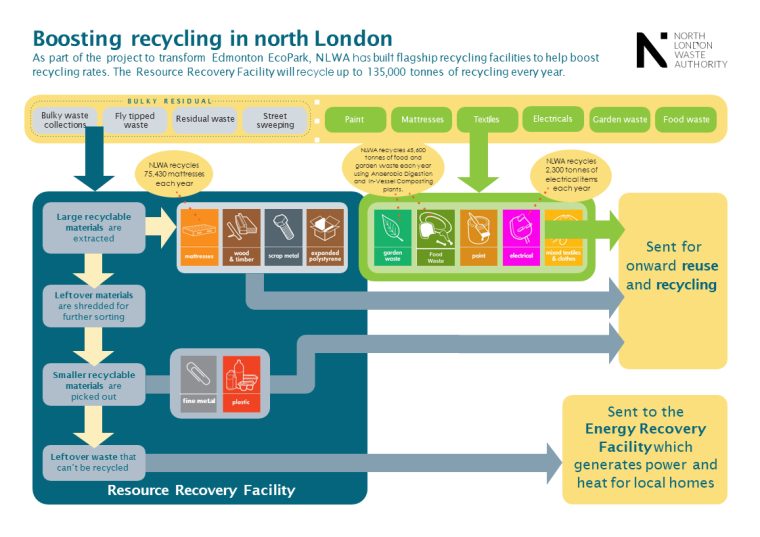The Resource Recovery Facility (RRF) at Edmonton EcoPark plays a crucial role in managing waste in north London. Borough vehicles deliver waste for sorting. Recyclable and reusable materials, like wood, plastics, and metal, are separated.
The RRF is designed to manage around 135,000 tonnes of recyclable materials annually, with capacity to handle even more as recycling levels increase.
The innovative design of the facility features 2,235 solar panels on a saw-tooth rooftop, generating enough electricity to power approximately 300 homes each year. The building has been designed to the most modern standards with systems to remove odours by 95% and infra-red sensors to detect fire threats quickly.
To understand in more detail what happens to waste and recycling at the RRF, see the RRF process outlined below:

- Bulky residual includes; Bulky waste collections, fly tipped waste, residual waste, street sweeping, paint, mattresses, textiles, electricals, garden waste, food waste.
- Large recyclable materials are extracted at the Resource Recovery Facility (RRF), including mattresses, wood and timber, scrap metal and expanded polystyrene. NLWA recycles 75,430 mattresses each year.
- Leftover materials are shredded for further sorting at the RRF.
- The RRF picks smaller recyclable materials out including fine metal and plastics and are then sent for onward reuse and recycling.
- Leftover waste that can't be recycled at the RRF is sent to the Energy Recovery Facility which generates power and heat for local homes.
- Paint, mattresses, textiles, electricals, garden waste and food waste are sent for onward reuse and recycling.
- NLWA recycled 2,300 tonnes of electrical items each year.
- NLWA recycles 46,500 tonnes of food and garden waste each year using Anaerobic Digestion and In-Vessel Composting plants.
 Hornsey Street Reuse and Recycling centre - REOPENING
Hornsey Street Reuse and Recycling centre - REOPENING
